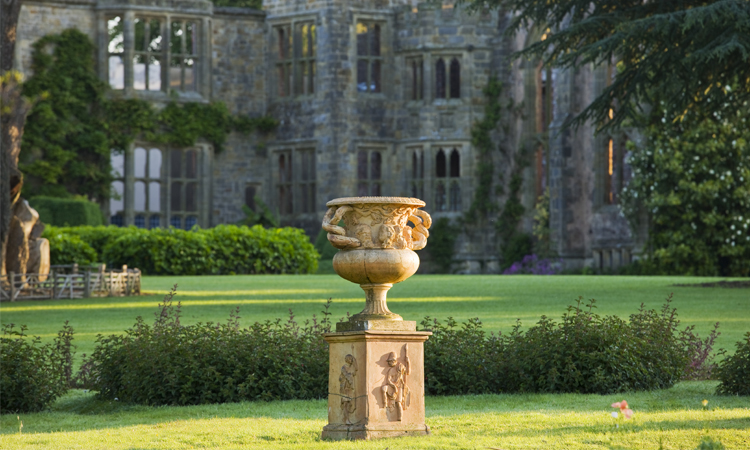Nymans, a renowned National Trust garden in West Sussex, has unveiled a new ‘Garden in the Ruins’, created within the remains of the Great Hall which was lost in a catastrophic fire in 1947 and has been inaccessible since.

Image: Clive Nichols
The flamboyant garden reflects the plantsmanship and artistry of the Messel family, who bought Nymans in the 1890s and began creating one of the UK’s most exquisite gardens, home to plant collections of international significance. Ludwig Messel and his son Leonard were keen plantsmen, sponsoring plant hunting expeditions and working with their Head Gardeners James and Harold Comber to introduce many plant hybrids which remain popular today.
Assistant Head Gardener Nick Delves, who researched and designed the new garden, said: “The Great Hall hadn’t been accessible for 75 years, but the enclosed space left behind by the fire provided an exciting opportunity to design a new garden. We wanted people to be able to see inside for the first time, but we also wanted to showcase Nymans’ plant collection and its huge importance.”
The garden includes many plants introduced to western horticulture by the Messel family and their head gardeners, all grown in giant planters and pots. These include:
- Camellia ‘Leonard Messel’
- Eucryphia x nymansensis ‘Nymansay’
- Eucryphia x nymansensis ‘Nymans Silver’ (discovered by Alistair Buchanan, who did much to restore Nymans, his family seat, after the Great Storm of 1987)
- Forsythia suspensa ‘Nymans’
- Lonicera etrusca ‘Michael Rosse’
- Magnolia x loebneri ‘Leonard Messel’
- Rhododendron decorum ‘Mrs Messel’
- Skimmia japonica ‘Nymans’
The Trust’s National Curator of Living Collections, Alison Crook, said: “Nymans contains one of the most significant and eclectic living collections within the National Trust, showcasing a huge range of beautiful and unusual plants from all around the world – this is a lovely opportunity to see some of them in a smaller space, giving visitors an opportunity to enjoy them close-up.”
Horticultural botanist Joanne Ryan added: “Nymans and its creators were at the heart of important times in horticultural and plant introduction and collection history. Both the Messels and Combers should be thought of alongside other great horticultural influences of the period. The relationship at Nymans between the garden owners and their head gardeners and how they selected plants, cultivated and developed the garden gives us a living legacy to enjoy and learn from with every visit. Rare, unusual and outstanding plants abound, many from wild source, and many selections are still stalwarts of gardens today.”
The cool, calm garden also features a number of ferns, which were selected by members of local dementia support groups: Dicksonia antarctica (soft tree fern), Matteuccia struthiopteris (shuttlecock fern) and Osmunda regalis (royal fern), which is descended from original specimens planted next to the pond in the Arboretum.
For the design, Nick Delves took his cue from acclaimed 20th-century British costume and stage set designer Oliver Messel, whose grandfather Ludwig began the gardens at Nymans.
He continued: “During research at the Victoria and Albert Museum, Glyndebourne and the University of Bristol Theatre Collection, I found that Oliver used gardens and landscapes extensively in his sets, such as statuary, topiary and viewpoints. As well as celebrating the unique plant collection found at Nymans, I wanted to reflect the importance of Oliver Messel’s theatre design work and creative flair.”
Decorative weathered steel screens divide up the space, echoing the ‘flats’ Messel would have used in his theatre scenery. Their rusty colours complement the reds and browns of the surrounding brickwork. The screens include laser-cut patterns that reference the family, their garden and the Great Hall itself, including the Messel family crest, a cedar of Lebanon, and the hall’s medieval-style windows.
Three water features reflect the fountains in the Wall and Rose Gardens, while giant oak planters are based on originals which once stood in front of the house in the 1920s.
As the garden evolves, the Nymans team hope to add further features including topiary and sculpture to reflect more of the wider garden.
The garden is a ‘quiet space’ where people are encouraged to pause, relax and enjoy the views of the garden and across the Sussex Weald.
Nick’s design tips for smaller spaces
- Use screens to divide your space. This could be a decorative panel or trellis, or use plants such as bamboo.
- It might sound surprising, but large plants look great in a small space.
- Limit your colour palette. Extra seasonal colour can be introduced with pots, for example tulips and dahlias.
- Play with contrasting leaf shapes and textures and include evergreens to give year-round interest.
- Don’t forget to incorporate seating so you can enjoy your space.
- Include a water feature for visual appeal and sound.
- For a more unified effect, limit the number of hard landscaping materials, for example sandstone, brick and oak.
Nick’s container growing tips
- Choose a frost-proof container.
- Ensure good drainage - make sure there are holes in the bottom of the container and then cover with pieces of broken pot.
- Use a mix of loam, peat free and home compost. Add a slow-release fertilizer and some water retaining granules.
- Use ericaceous food if growing acid-loving plants like camellias or rhododendrons.
- Keep weed free.
- In the growing season feed weekly with a liquid feed.
- Monitor and water regularly, especially in dry periods. Don’t forget to water sparingly over winter if it is dry.
- Move pots into shade when leaving them for any period of time.
- Prolong flowering of annuals and some perennials by deadheading.
- Stake trees to prevent wind rock.
Related
Comments
Comments are disabled for this post.

.png)


 to add an item to your Itinerary basket.
to add an item to your Itinerary basket.




